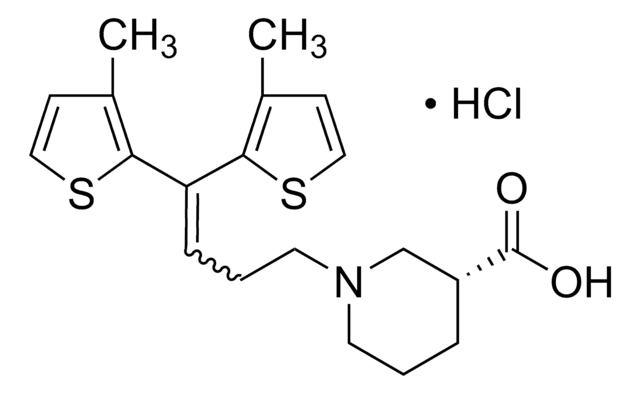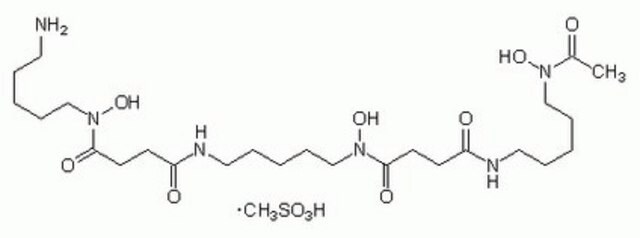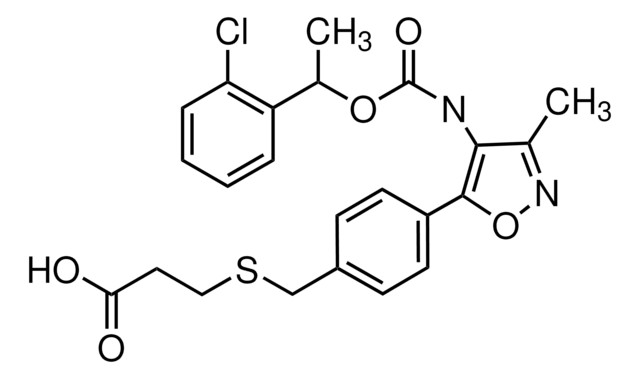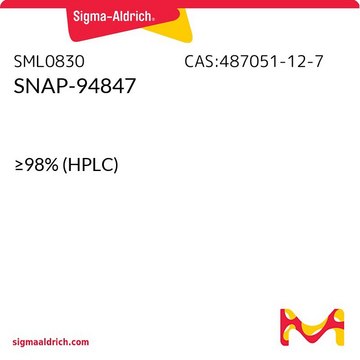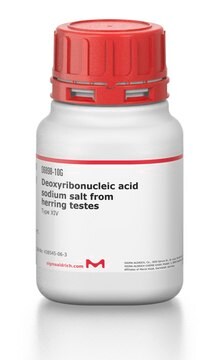Kluczowe dokumenty
S1069
(S)-SNAP-5114
≥98% (HPLC), solid
Synonim(y):
(S)-1-[2-[Tris(4-methoxyphenyl)methoxy]ethyl]-3-piperidinecarboxylic acid
About This Item
Polecane produkty
Poziom jakości
Próba
≥98% (HPLC)
Formularz
solid
aktywność optyczna
[α]/D -8 to -13°, c = 1 in chloroform-d
kolor
white
rozpuszczalność
DMSO: >5 mg/mL
H2O: insoluble
temp. przechowywania
−20°C
ciąg SMILES
COc1ccc(cc1)C(OCCN2CCC[C@@H](C2)C(O)=O)(c3ccc(OC)cc3)c4ccc(OC)cc4
InChI
1S/C30H35NO6/c1-34-26-12-6-23(7-13-26)30(24-8-14-27(35-2)15-9-24,25-10-16-28(36-3)17-11-25)37-20-19-31-18-4-5-22(21-31)29(32)33/h6-17,22H,4-5,18-21H2,1-3H3,(H,32,33)/t22-/m0/s1
Klucz InChI
VDLDUZLDZBVOAS-QFIPXVFZSA-N
Działania biochem./fizjol.
Cechy i korzyści
Hasło ostrzegawcze
Warning
Zwroty wskazujące rodzaj zagrożenia
Zwroty wskazujące środki ostrożności
Klasyfikacja zagrożeń
Eye Irrit. 2 - Skin Irrit. 2 - STOT SE 3
Organy docelowe
Respiratory system
Kod klasy składowania
11 - Combustible Solids
Klasa zagrożenia wodnego (WGK)
WGK 3
Temperatura zapłonu (°F)
Not applicable
Temperatura zapłonu (°C)
Not applicable
Środki ochrony indywidualnej
dust mask type N95 (US), Eyeshields, Gloves
Wybierz jedną z najnowszych wersji:
Masz już ten produkt?
Dokumenty związane z niedawno zakupionymi produktami zostały zamieszczone w Bibliotece dokumentów.
Nasz zespół naukowców ma doświadczenie we wszystkich obszarach badań, w tym w naukach przyrodniczych, materiałoznawstwie, syntezie chemicznej, chromatografii, analityce i wielu innych dziedzinach.
Skontaktuj się z zespołem ds. pomocy technicznej

